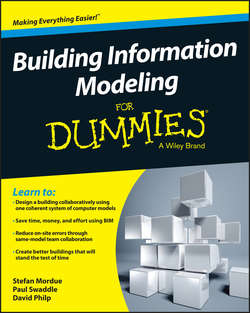Читать книгу Building Information Modeling For Dummies - Swaddle Paul - Страница 6
На сайте Литреса книга снята с продажи.
Part I
Getting Started with Building Information Modeling
Chapter 1
Defining Building Information Modeling (BIM)
Examining the A-B-Cs of BIM
ОглавлениеBIM stands alone as a word in its own right, and you can feel confident using it, instead of having to say “Building Information Modeling” in full every time. But when it comes to understanding what BIM really is and explaining it to other people, those three letters can be a very useful place to begin. The following list gives a bit more detail about the A-B-Cs of BIM, or, more accurately, the B-I-Ms!
B is for banana
One of the best ways we’ve found to describe BIM to someone without any knowledge of it is to grab a piece of fruit. Explain that you could develop a perfect 3D replica of the fruit in digital modeling programs or even by 3D-printing a copy, but that’s only one kind of representation of the fruit. It doesn’t include any of the fruit’s data; for example, its sugar content, calories, use-by date, country of origin, whether it has Fairtrade certification, and so on. The 3D object on its own isn’t enough to represent the fruit. It isn’t Banana Information Modeling. That’s the difference between 3D CAD and true information modeling.
✔ B: Because the B in BIM stands for building, think of this as the verb to build, and not just the noun, as if BIM was for just physical, discrete buildings. In fact, you can apply BIM to infrastructure, civil engineering, and landscape, along with large-scale public and private projects.
You’re modeling a process, the act of building something. Refer to Chapter 2 for more information on what the B in BIM means and for help on BIM for infrastructure.
✔ I: The I in BIM is about understanding that unless you have information embedded throughout the project content, the work you’re producing is telling only half of the story.
You don’t even really need to worry about the modeling in order to start applying BIM; you can put the processes and data exchanges into practice long before drawing work begins on a project. The real value in BIM is the ability to interrogate the model and find the data you need, when you need it. Turn to Chapter 3 for some great examples of information modeling from other industries, like aeronautics and automotive racing.
✔ M: The M stands for modeling. This aspect of BIM probably has the most history, and hundreds of programs for representing the built environment using 3D CAD techniques and virtual design and construction (VDC) are available. (In fact, the majority of free resources on BIM, especially in the United States, can put too much focus on the 3D modeling aspects of BIM.) Chapter 4 is about how the visual model should evolve in detail, but only as much as you require for the relevant output. The model should allow the output of whatever plan/section or perspective or walkthrough or 3D-printed model that you require.
One of the simplest ways you can explain BIM is that the project should be built twice: once fully modelled digitally and then again for real on the construction site.
After you comprehend the definition of BIM, the next step is to grasp what BIM is actually trying to achieve. BIM processes aim to make you (and the construction industry as a whole) more efficient, and to allow project teams to make savings in terms of cost, time, and carbon, and removing waste across the timeline. Chapter 5 provides a really simple overview of what BIM is trying to do and some of the key fundamentals you need to know.
